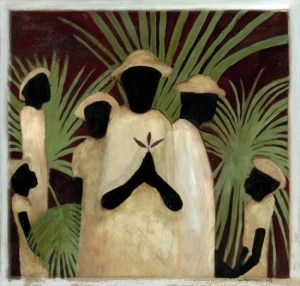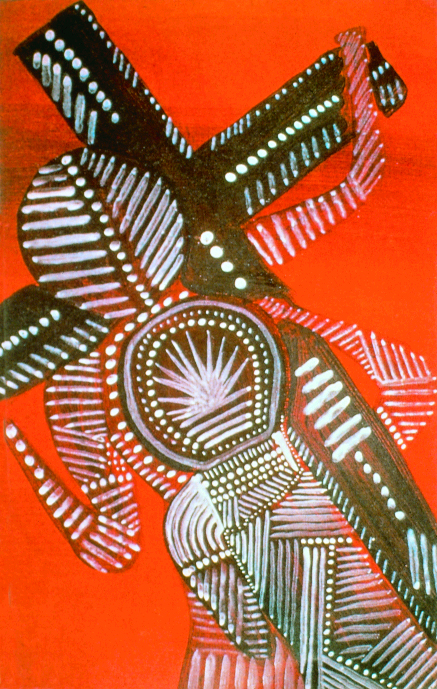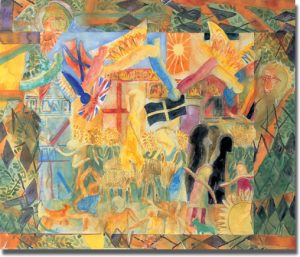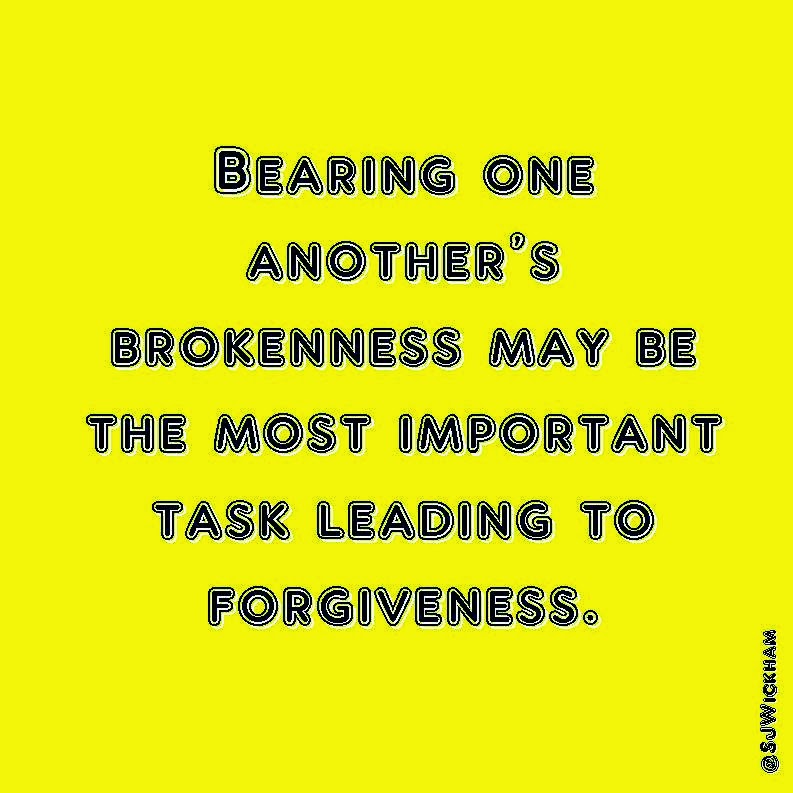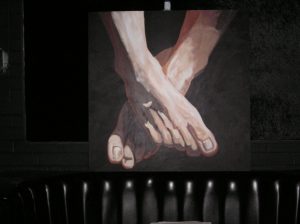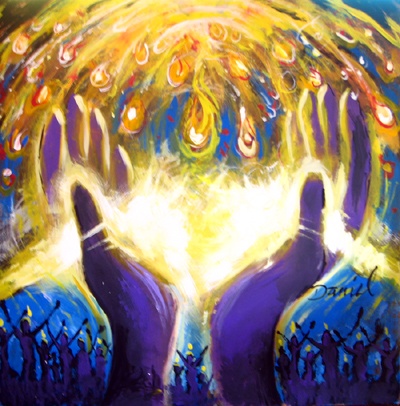It’s Holy week and Jesus’ journey towards the cross has begun. Many of us have already processed around the church on Palm Sunday, and bought our Easter eggs and hot crossed buns, diverting our attention from the real meaning of Easter to its commercialized version. How many of us are sucked in? What is the focus of your thoughts as we head through Holy week – is it on the life, death and resurrection of Christ or is it on the upcoming Easter egg hunt and whether it will be warm enough to wear your new spring outfit? Most of us know that Palm Sunday commemorates Jesus’ triumphant procession into Jerusalem on donkey’s back, but few of us are aware of the deeper and very subversive implications of this event. And as we walk through holy week towards the cross, Jesus’ actions become more and more subversive. We have in fact entered the most subversive week of Jesus life.
According to Borg and Crossan’s important book The Last Week (2007), it is probable that there were two processions going on into Jerusalem on Palm Sunday – one that symbolized the Roman culture of Jesus day and the other Jesus proclaiming his upside down kingdom.
It would have been customary for Pontius Pilate the Roman governor assigned to Judea and Jerusalem to come with his soldiers to Jerusalem for Passover. His procession would have come from the west at the head of a column of imperial cavalry and soldiers – an impressive and lavish procession specially designed to impress the people to discourage potential uprisings with a visual display of imperial power: cavalry on horses, foot soldiers, leather armor, helmets, weapons, banners, golden eagles mounted on poles, sun glinting on metal and gold.
On the other side of the city, down from the Mount of Olives in the north came Jesus and his humble procession – no pomp, no ceremony, dressed simply like the people, riding on the back of a donkey and followed by his disciples drawn from amongst the peasants and the common people. I imagine the lepers he had healed and the once blind man dancing and rejoicing with him. And there is Lazarus with Mary and Martha a living symbol of the triumph that this procession represents.
Here was the truly triumphant procession and the true rejoicing of the season. Shouts of “Hosanna! Blessed is the one who comes in the name of the Lord!” greeted their passing. But this was a radical procession that really thumbed its nose at the Roman Empire with its power and wealth.
Then Jesus headed to the temple, overturned the tables and threw out the moneylenders proclaiming loud and clear to the religious leaders that their alignment with the power of Rome was totally unacceptable to God. And he caps the week off with a Passover meal, not revealing himself as an emperor messiah his followers and even his disciples were hoping, but washing feet, indelibly imprinting on his disciples this final image of a slave, the last loving act of an upside down king.
This week brought the savage conflict between the kingdom of God and the empire of Rome to a head. Not just a theological statement but a political one as well. Jesus’ belief in the liberating, inclusive, non-violent, peace-seeking kingdom of God was over against the oppressive, greedy, elite-loving, peasant-starving kingdom of Rome. No wonder he was so angry with the Temple hierarchy – the chief priest, the elders and the scribes – who had become servants of the empire and not of the God’s kingdom.
Jesus’ ride into Jerusalem was obviously headed for a collision with the powerful Roman empire – a collision that would cost his life and change history forever. Jesus triumphal entry into Jerusalem may have begun with crowds shouting Hosanna but it ends with Good Friday and the apparent triumph of the powers of the Roman Empire and of Satan. It does not end with a gold crown but with a crown of thorns. Jesus triumphal entry ends with his willingness to take into himself all the pain and suffering of our world so that together we can celebrate the beginning of a new procession on Easter Sunday – a procession that leads us into God’s banquet feast and the wonder of God’s eternal world.
The question for all of us as we walk with Jesus from Palm Sunday to Good Friday is: Where is our allegiance? Are we part of that ragamuffin discipleship band following Jesus, fully aware that we are on a collision course with the values of our secular culture? Do we only want to follow Jesus when we think he promises wealth, power and happiness. Have we so misunderstood him and his purpose that we are ready to turn against him when he turns out not to be who we thought he was?
Perhaps, we’re not part of Jesus’ procession at all. Perhaps we’re standing at the other gate, cheering for the symbols of empire, enthusiastically, supporting our own idea of a messiah, that looks more like the Roman emperor than the humble servant Jesus. Dazzled by power, attracted to wealth, wanting to identify with the victors, not the vanquished, hoping to be counted as one of the elites of our time.
Actually, most of us are probably part of both processions – wanting to follow this Jesus whom we find so attractive yet whom we don’t fully understand, but also caught up in the excitement of Easter egg hunts and spring fashion displays.
The beauty is that Jesus, in his humanity, sees and knows all of us. . . the flawed humanity that surrounds him. . . the flawed humanity of each of us. . . and he sees it and he forgives it, and loves us, and gives his blessing to all of us as he clops along the dusty road toward his confrontation with power, his time of trial, his abandonment, his death.
———————————-
This post is adapted from this one written for Palm Sunday a couple of years ago. You may also like to check out the resources we have posted for Holy week.
Resources for Maundy Thursday:
Resources for Celebrating Holy Week With Kids:
I just came across this beautiful prayer by Joseph Tetlow, author of Making Choices in Christ and Choosing Christ in the World, on the Ignatian Spirituality website. I love breath prayers and this is particularly moving as we move through Holy week. The prayer is a contemporary paraphrase of the Anima Christi. Nothing like anticipation to keep us going.
I choose to breathe the breath of Christ
that makes all life holy.
I choose to live the flesh of Christ
that outlasts sin’s corrosion and decay.
I choose the blood of Christ
along my veins and in my heart
that dizzies me with joy.
I choose the living waters flowing from his side
to wash and clean my own self and the world itself.
I choose the awful agony of Christ
to charge my senseless sorrows with meaning
and to make my pain pregnant with power.
I choose you, good Jesus, you know.
I choose you, good Lord;
count me among the victories
that you have won in bitter woundedness.
Never number me among those alien to you.
Make me safe from all that seeks to destroy me.
Summon me to come to you.
Stand me solid among angels and saints
chanting yes to all you have done,
exulting in all you mean to do forever and ever.
Then for this time, Father of all,
keep me, from the core of my self,
choosing Christ in the world. Amen.
– Joseph Tetlow SJ
Let us enter the city of God today,
Rejoicing with the son of God.
Let us join the throngs of expectant followers,
And shout for joy at Christ’s coming.
Let us walk with Jesus towards the cross,
Longing still for things unseen.
For justice, and mercy and freedom.
Let us stumble along the path Christ walked
Our hearts aching for things not complete,
For wholeness and peace and abundance.
As we breathe in God’s life giving breath
Let us long for what is yet to come.
For a new world of righteousness and truth.
One true God, we move slowly toward your eternal future,
With perseverance and eager anticipation,
Confident that you can orchestrate everything,
To work towards something good and beautiful.
“Put away from you all bitterness and wrath and anger and wrangling and slander, together with all malice, and be kind to one another, tenderhearted, forgiving one another, as God in Christ has forgiven you.”
— Ephesians 4:31-32 (NRSV)
The sins of others,
Those I can see,
That of sisters and brothers,
With brokenness like me.
Sin explains something,
Something gorgeously Divine,
That sin’s just a thing,
To make God’s forgiveness mine.
When I see brokenness in others it reminds me of my own brokenness. We are all so wonderfully fallible. That is the inducement into the very heart of God, a day by day journey.
***
But there is an equivalent reality for the person given to a dark attitude, a disposition of annoyance, and a manner of speech ensuing – “shouting” and “abusive”. Recalling a recent case of road rage enacted on a highway, a 60s male driver in one hell of a rush, there was no convincing him to slow down and take it easy, as he barked and threw his arms about furiously. Something had riled him and his brokenness had taken him into a dark destination manifest to crimes against fellow road users. We could only get out of his way and pray.
There are vast dichotomies of attitude, disposition, and manner of behavior. Ours is to bear one another’s brokenness.
Forgiveness – Understood In Context of Brokenness
The road rage perpetrator couldn’t be reasoned with – but he is still a member of society. When we understand there is a dark source of brokenness within each of us – resonating the need we each have for a holy God to be Lord over our lives – we can wrestle safely with the dark forces engaged within another person. Their brokenness is obvious only because ours is, too.
He needed help. We all do. We should pray all the more that our warm and empathic genuineness might occasionally melt these secondary emotions of anger and rage.
When we reconcile what brokenness is – that the insufficiency and damage of a person’s biology, life experience, and personality explain them – we can grasp God’s sight on matters. Forgiveness is not so hard then. There is an explanation.
Embracing Humanity’s Wonderful Fallibility
What is still so strangely negative – that we are fallen, broken vessels for use – is an astounding encouragement when we recognize what God has done for us in Christ. Our sin propounds God’s grace all the more. It means we are not finished in our sin; that God has had the final, hope-filled word.
As we embrace our own sinful natures, we quicken in embracing the not-so-glorious imperfections of others. Their ugly attitudes and behaviors simply convince us of our ever personal need for a holy God as Lord over all of life.
Bearing one another’s brokenness is a resplendent privilege of each of us who knows the Lord our God. Not only are we commanded to love one another – even in thick of encroaching sin – but we are called to bear these things with a forgiving instinctiveness, as Christ: “Father, forgive them, for they know not what they do!”
And because we are capable of such forgiving instinctiveness we are enabled to do it, upon surrender, and then see it in all its redemptive power. This is when the Holy Spirit’s power comes right into its own, as bonds of hate, fear, and transgression are broken down, block by ugly block.
***
We were saved from engaging in sin to the extent that we might truly marvel at God’s forgiving grace and exemplify it. We still get it wrong, but every broken moment can be redeemed if we wish. Bearing one another’s brokenness may well be the most important task leading to forgiveness.
© 2014 S. J. Wickham.
originally posted at: epitemnein-epitomic.blogspot.com.au
Bio
Steve Wickham is a Baptist Pastor in Perth Australia who holds Degrees in Science, Divinity, and Counseling. His passion is encouraging people to become the best they want to be.
Passage: 1 Corinthians 12:12-26
I giggled to myself the first time I read through this passage. Certain questions would run through my mind like “How would I react if my thumbs packed their bags said to me ‘I don’t need you!’” or “Lord, what do you mean give unrepresented parts greater honor? Should I acknowledge my collar bones more often?”
I didn’t quite understand what the passage was hinting at until I imagined what life would be like without these parts- without opposable thumbs or bones that support you when you stand. Every part is essential and has a purpose- even down to the skin between our thumb and index finger. The Lord tells us in this passage that we are all part of the body of Christ. This is something we’re all familiar with; we’ve heard variation after variation in church. Yes okay, every member of our church has a purpose. Yes okay, we must remain united to function. But what if we thought about this passage in a global sense? What if we thought about the body of Christ extending across the oceans and encompassing all of our brothers and sisters throughout each and every continent? We are the body of Christ in disunity because so often we forget the enormity of the global Church.
Many times we remain so focused on our lives that we unconsciously say to the rest of the body body “because I am not a hand, I do not belong to the body. I can function on my own.” This parallels our treatment to the rest of the global church. We have enough money, we have our own comforts and our own bible studies- We can function on our own. Ah, but this is the lie of disunity. This passage in Corinthians implies that we NEED our brothers and sisters in every country because “although we are many parts, we are one body”. We need them as much as they need us. We need each other in order to see the fullness and splendor of the united body of Christ.
Every part of the body is required to function. This Lenten season I urge us to live in daily awareness of our brothers and sisters who have been deemed “dispensable”. We must remember our counter parts in other countries not just to function but to thrive. There must be no division in the global Church- to the point that if they suffer we will suffer with them. And even more beautifully, there must be no division in the global church to the point that when they are honored we can genuinely rejoice with them.
Bio:
My name is Sajira Mae Awang, a Filipino-American currently living in an informal settlement of Quezon City. I’ve been given this beautiful opportunity to be challenged and grow through my masters in Transformational Urban Leadership. All for the love of the poor, because it’s the only thing that matters most to me besides Jesus.
For Lent this year, I chose to add this jigsaw puzzle by American artist Charles Wysocki. On one level it’s a stylized version of Americana–a rural setting with a large sheep in the foreground, with more sheep, simple buildings, and trees in the background.
And yet for me this jigsaw puzzle has also become a way of slowing down and becoming quiet. I’m not particularly legalistic about it. I don’t have to work on it every day. I don’t have a deadline of completing it before Lent is over. But every so often I pause to put a few more pieces together–a few moments in the morning or on my lunch break, perhaps alonger time some evening.
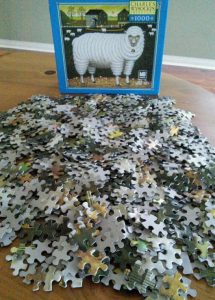 I chose this puzzle in part because of the title. Charles Wysocki called it “Shepherd’s Pal” which is so appropriate for this Lenten season as I reflect on Jesus, the Great Shepherd, the One who lays down his life for his sheep, who knows each one of us by name and calls us (John 10:1-18). It reminds me that whatever I might do, whatever roles I might have in life, I am the Shepherd’s pal so to speak–a follower of Jesus with the great honor of being called his friend (John 15:15).
I chose this puzzle in part because of the title. Charles Wysocki called it “Shepherd’s Pal” which is so appropriate for this Lenten season as I reflect on Jesus, the Great Shepherd, the One who lays down his life for his sheep, who knows each one of us by name and calls us (John 10:1-18). It reminds me that whatever I might do, whatever roles I might have in life, I am the Shepherd’s pal so to speak–a follower of Jesus with the great honor of being called his friend (John 15:15).
This jigsaw puzzle also helps me to connect with the brokenness and healing of God’s family. As the body of Christ, the church is meant to be whole and healthy, to function together with each part contributing to the whole (1 Corinthians 12:1-31). To change the Pauline metaphor, perhaps we could also say that the church is like a giant jigsaw puzzle where each piece is part of the bigger picture.
Only it seems we haven’t yet figured out how to put the pieces together. What’s more, we sometimes seem unsure that we’re even part of the same picture. There is so much brokenness–within local congregations and between them, in denominations and in between, over biblical teaching and theology, over the definitions of right and wrong, inside and outside. Jesus’ prayer for unity (John 17:1-26) has not yet been fully accomplished.
And so as I sort through the pieces of my jigsaw puzzle and put them together, I also sort through my questions. Are difference and disunity in this life and in the church inevitable? Is it too simplistic to expect that all of the pieces will fit together smoothly with no missing pieces and no extras? Do we rather need to accept our brokenness with humility as a kind of gift?
My questions dissolve to prayer. I don’t yet have everything together in the perfect picture—not in my jigsaw puzzle and not in the brokenness I see all around me in the church and in the world. I long to heal all those wounds and make all things right, but I am not God. I am not the Great Shepherd, only the Shepherd’s pal.
So I pray, Lord, have mercy. Christ have mercy. And I wait for the One who “is before all things, and in him all things hold together” (Colossians 1:17). Amen.
April Yamasaki is a pastor and also the author of Sacred Pauses: Spiritual Practices for Personal Renewal. She has recently completed a companion resource–the Sacred Pauses Group Leaders’ Guide and Scripture Index is now available as a free download from her website, aprilyamasaki.com.
Blessed are those who persecute?
Blessed are those who are persecuted because of righteousness, for theirs is the kingdom of heaven. (Matthew 5:10)
As we approach Good Friday it is appropriate for Christians to contemplate the crucifixion of Christ and the persecution that Jesus suffered at the hands of the religious and political authority figures in Jerusalem.
Nor should we forget the faithful who are suffering for their faith in many places in the world today.
But should we Christians turn a blind eye to the suffering that we and our ancestors, the church universal, have inflicted on others in the name of Christ over the ages? For it is historical fact that within a few short centuries the persecuted became the persecutors, that confessing Christians tortured and killed Pagans and Heretics throughout Christendom, calling it good and righteous.
This is no mere historical issue for me or for some of the communities I am involved in, for many people I know and move amongst are Pagan – who self identify as such, and have suffered as such. They are much like you and me, they work in business and teaching and IT, but they differ in one important respect: the worship many gods and goddesses, nature spirits of the fertile earth. And one thing I hear time and time again from them is stories of persecution at the hand of self righteous Christians. They find themselves reviled, vilified, falsely accused of Satan worship and (somewhat ironically) of child abuse, and of being cast out of churches they were trying to connect with.
And yet, I have found that when I approach my Pagan neighbours with respect, more often than not they are respectful towards me. And when I listen in order to understand, they are happy to enter into conversation and are open to what I have to say as well. Many have become friends. And through these conversations in community I have discovered a truth: that disagreement need not lead to disrespect, that truth is best spoken in love.
So what will I reflect on this Lent? I will reflect on the capacity we, the church, have for persecution, as much as we would like to live in denial. I will reflect on the darkness at the door, on the potential Pharisee that lurks within us all. And I will reflect on the Messiah, the one who taught us what real blessedness was about.
Bio
Matt Stone is a blogger from Sydney, Australia, and has been blogging about world
religions since 2004. His writing flows out of experiences amongst Christians, Hindus,
Buddhists, Wiccans and the “spiritual but not religious,” both as a Christian and prior
to that. His work may be found at mattstone.blogs.com.
As an Amazon Associate, I receive a small amount for purchases made through appropriate links.
Thank you for supporting Godspace in this way.
When referencing or quoting Godspace Light, please be sure to include the Author (Christine Sine unless otherwise noted), the Title of the article or resource, the Source link where appropriate, and ©Godspacelight.com. Thank you!

